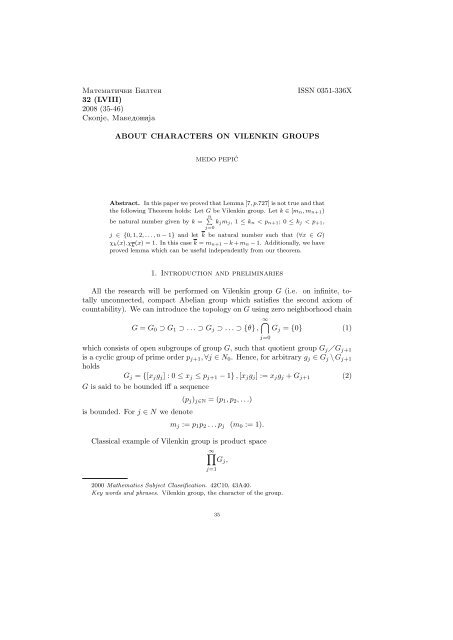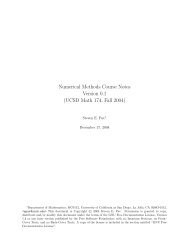Skopje, Makedonija ABOUT CHARACTERS ON VILENKIN ...
Skopje, Makedonija ABOUT CHARACTERS ON VILENKIN ...
Skopje, Makedonija ABOUT CHARACTERS ON VILENKIN ...
You also want an ePaper? Increase the reach of your titles
YUMPU automatically turns print PDFs into web optimized ePapers that Google loves.
Matematiqki Bilten ISSN 0351-336X<br />
32 (LVIII)<br />
2008 (35-46)<br />
<strong>Skopje</strong>, <strong>Makedonija</strong><br />
<strong>ABOUT</strong> <strong>CHARACTERS</strong> <strong>ON</strong> <strong>VILENKIN</strong> GROUPS<br />
MEDO PEPIĆ<br />
Abstract. In this paper we proved that Lemma [7,p.727] is not true and that<br />
the following Theorem holds: Let G be Vilenkin group. Let k ∈ [m n,m n+1 )<br />
∑<br />
be natural number given by k =<br />
n k j m j ,1≤ k n
36 MEDO PEPIĆ<br />
where G j = {0, 1} is a cyclic group of the second order for all j ∈ N, equipped by<br />
discrete topology, with the component adding (note that adding in each component<br />
is done by module 2). It’s direct generalization is group<br />
∞∏<br />
G = Z nk ,<br />
k=0<br />
where Z nk := {0, 1, 2,...,n k − 1} ,n k ≥ 2, is a cyclic group of order n k (k ∈ N 0 )<br />
equipped by discrete topology.<br />
Arbitrary x ∈ G has the unique representation in the following form<br />
∞∑<br />
x = x j g j ,x j ∈{0, 1, 2,...,p j+1 − 1} (3)<br />
j=0<br />
where g j ∈ G j G j+1 are previously arbitrary chosen and fixed, and for all j ∈ N 0<br />
holds<br />
{<br />
}<br />
∞∑<br />
G j = x ∈ G : x s g s ,x s =0, for 0 ≤ ss) ∧n j(n) ≠0,then
<strong>ABOUT</strong> <strong>CHARACTERS</strong> <strong>ON</strong> <strong>VILENKIN</strong> GROUPS 37<br />
j(n)<br />
∑<br />
n = n j m j ,n j ∈{0, 1, 2,...,p j+1 − 1}∧1 ≤ n j(n)
38 MEDO PEPIĆ<br />
Then all the elements of the subgroup Γ j+1 have been ordered and by induction<br />
all the elements of Γ. In this kind of ordering, for n given by (5), obviously holds<br />
∞∏<br />
χ n = χ nj<br />
m j<br />
, 0 ≤ n j
<strong>ABOUT</strong> <strong>CHARACTERS</strong> <strong>ON</strong> <strong>VILENKIN</strong> GROUPS 39<br />
of the corresponding coefficients. Addition of elements x =(x j ) j∈N0 and y =<br />
(y j ) j∈N0 in G we denote by + and define it by component addition. Component<br />
addition for arbitrary coordinate j ∈ N 0 is addition mod p j+1 .<br />
For arbitrary n ∈ N given by (5) and arbitrary x ∈ g given by (3) we have<br />
χ n (x) =<br />
∞∏<br />
j=0<br />
χ n j<br />
m j<br />
(x), 0 ≤ n j
40 MEDO PEPIĆ<br />
(19) becomes<br />
χ n (x) =<br />
∞∏<br />
j=0<br />
r n j<br />
j (x), 0 ≤ n j
<strong>ABOUT</strong> <strong>CHARACTERS</strong> <strong>ON</strong> <strong>VILENKIN</strong> GROUPS 41<br />
d) Γ 0 = {χ 0 }∧Γ 1 = {χ 0 ,χ 1 }∧Γ 2 = {χ 0 ,χ 1 ,χ 2 ,χ 3 ,χ 4 ,χ 5 }∧Γ 3 = {χ j :0≤ j
42 MEDO PEPIĆ<br />
e) For n ∈ N given by (5) and x ∈ G given by (3) holds<br />
⎛ (<br />
)<br />
∞∑ k j<br />
j∑<br />
⎞<br />
χ n (x) =exp⎝2πi<br />
· x s m s<br />
⎠ .<br />
m j+1<br />
j=0<br />
s=0<br />
Proof. (Lemma 1).<br />
a) By the facts that r n ∈ Γ n+1 Γ n and Γ n+1 Γ n is a cyclic group of prime<br />
order p n+1 follows r p n+1<br />
n ∈ Γ n Γ n−1 . Therefrom and using the fact that<br />
Γ n Γ n−1 is a cyclic group of prime order p n follows r p n+1.p n<br />
n ∈ Γ n−1 Γ n−2 .<br />
By continuing reasoning describe above we conclude that for each 0 ≤ s ≤ n<br />
holds rn<br />
pn+1.pn....ps+1 ∈ Γ s Γ s−1 . This proves assertion a) since obviously holds<br />
(∀s ∈{0, 1, 2,...,n})p n+1 .p n ...p s+1 = m n+1<br />
m s<br />
.<br />
Let us notice, that from (21) follows<br />
r p n+1.p n ...p s+1<br />
n = r p s+1<br />
s = r s−1 .<br />
b) If s>n,then r n ∈ Γ s and therefrom r n (x s g s )=1sincex s g s ∈ Γ s Γ s+1 .Let<br />
us arbitrarily choose s ∈{0, 1, 2,...,n}. Then x s g s ∈ Γ s Γ s+1 , for all 1 ≤<br />
m n+1<br />
ms<br />
x s
<strong>ABOUT</strong> <strong>CHARACTERS</strong> <strong>ON</strong> <strong>VILENKIN</strong> GROUPS 43<br />
χ k (x) =<br />
n∏<br />
j=0<br />
e) By (5) ∧ (18 ∗ ) ∧ c) wehave<br />
χ n (x) =<br />
r kj<br />
j<br />
n (x) = ∏<br />
k j ·<br />
exp ⎜<br />
⎝ 2πi<br />
j=0<br />
j=0<br />
⎛<br />
⎞<br />
j∑<br />
x s m s<br />
⎟<br />
⎠<br />
s=0<br />
m j+1<br />
⎛ (<br />
)<br />
n∑ k j<br />
j∑<br />
⎞<br />
= exp⎝2πi<br />
· x s m s<br />
⎠ .<br />
m j+1<br />
∞∏<br />
j=0<br />
r kj<br />
j<br />
s=0<br />
∞ (x) = ∏<br />
k j ·<br />
exp ⎜<br />
⎝ 2πi<br />
j=0<br />
j=0<br />
⎛<br />
⎞<br />
j∑<br />
x s m s<br />
⎟<br />
⎠<br />
s=0<br />
m j+1<br />
⎛ (<br />
)<br />
∞∑ k j<br />
j∑<br />
⎞<br />
= exp⎝2πi<br />
· x s m s<br />
⎠ .<br />
m j+1<br />
s=0<br />
□<br />
Proof. (Theorem 1). Let G be given Vilenkin group. Let k ∈ [m n ,m n+1 )be<br />
natural number given by<br />
k =<br />
n∑<br />
k j m j , 1 ≤ k n
44 MEDO PEPIĆ<br />
k =<br />
n∑<br />
b j m j , 1 ≤ b n
<strong>ABOUT</strong> <strong>CHARACTERS</strong> <strong>ON</strong> <strong>VILENKIN</strong> GROUPS 45<br />
x =(0, 0,...,0,g n−1 , 0,...).<br />
For such x we have x n−1 =1∧ x s =0foralls ≠ n − 1, so in that case (29)<br />
implies<br />
k n−1 + b n−1<br />
m n<br />
which is according to (30), equivalent to<br />
k n−1 + b n−1<br />
p n<br />
+ 1<br />
p n<br />
∈ N 0 , i.e.<br />
· m n−1 + k n + b n<br />
m n+1<br />
· m n−1 ∈ N 0 ,<br />
k n−1 + b n−1 +1<br />
p n<br />
∈ N 0 .<br />
If we take account that 0 ≤ k n−1
46 MEDO PEPIĆ<br />
Substituing (33) in (26) we obtain<br />
n−1<br />
∑<br />
k =(p n+1 − k n )m n + (p j+1 − k j − 1)m j = m n+1 − k + m n − 1.<br />
j=0<br />
Now it is easy to check, that for k determined in a such way, really,<br />
holds true. Namelly,<br />
⎛<br />
n∏<br />
χ k · χ k<br />
= ⎝<br />
j=0<br />
r kj<br />
j<br />
⎞ ⎛<br />
n∏<br />
⎠ · ⎝<br />
χ k · χ k<br />
= χ 0<br />
j=0<br />
r bj<br />
j<br />
⎞<br />
⎠ = r p n+1<br />
n ·<br />
⎛<br />
n−1<br />
∏<br />
⎝<br />
j=0<br />
r pj+1−1<br />
j<br />
⎞<br />
⎠ = χ 0<br />
(according to (23) and (21).<br />
□<br />
References<br />
[1] Agaev,G.N.,Vilenkin,N.Ya.,Džafarli, G.M., Rubinštein, A. I., Mul ′ tiplikativnye<br />
sistemy funkciĭ i garmonicheskiiĭ anaiz na nul ′ tiplikativnyh gruppah, Elm, Baku, 1981.<br />
[2] B. Aubertin and J.J.F.Fournier, An Integrability Theorem for Unbounded Vilenkin Systems,<br />
Analysis Math. 23 (1997) 159-187.<br />
[3] S. Fridli and F. Schipp, On the everywhere divergence of the Vilenkin-Fourier series, Acta<br />
Sci. Math.(Szeged), 48 (1985), 155-162.<br />
[4] Hewitt, E. and Ross, K. A., Abstract harmonic analysis, vol. I, Springer-Verlag, Berlin,<br />
1963; translated in Nauka, Moskva, 1975.<br />
[5] C. W. Onneweer and D. Waterman, Uniform convergence of Fourier series on groups,<br />
I, Mach. Math. J. 18(1971), 265-273.<br />
[6] Zbl pre 01310541 Pepić Medo, Integrability and summability of Vilenkin series. (Serbian.<br />
English summary) (doctorate disertation).<br />
[7] N. Tanović-Miller, Integrability and L 1 convergence classes for unbounded Vilenkin systems,<br />
Acta Sci. Math. (Szeged) 69 (2003), 687-732.<br />
[8] Vilenkin, N. Ya., On a class of complete orhtonormal systems, Izv. Akad. Nauk. SSSR<br />
Ser. Math. 11(1947), 363-400; translated in Amer. Math. Soc. Transl. 28(1963), 1-35.<br />
Department of Mathematics, University of Sarajevo, Zmaja od Bosne 33-35, Bosnia<br />
and Herzegovina,<br />
E-mail address: mpepic@lol.ba














